Coron in the province of Palawan, Philippines is often visualized through images of pristine islands, serene beaches and tranquil waters. These images, while accurate, mask a pressing challenge: the real impact of tourism.
The allure of Coron’s breathtaking landscapes draws travelers worldwide, leading to a complex issue of balancing ecosystem preservation with the influx of visitors. Each idyllic scene is counteracted by the growing need to address, manage and mitigate the environmental strains imposed by tourism. The task of sustaining Coron’s beauty while accommodating its popularity is an ongoing, intricate endeavor.
The term “tourism” can evoke a spectrum of reactions and interpretations, owing to its multifaceted nature and varying impacts globally. Essentially, a tourist is someone who travels for pleasure, engaging in sightseeing and typically staying in hotels. However, this straightforward definition often overshadows the complex dynamics involved in tourism.

This definition has evolved over the recent years. It’s not just about an individual visiting new locales for personal enrichment or ticking off experiences, but now it is increasingly scrutinized for the footprint a tourist leaves behind. The transient nature of tourism can cast a shadow over the joy and discovery that travel is intended to incite. The challenge lies in reconciling the quest for personal experiences with the imperative of sustainable and responsible tourism practices.
Tourism, like a double-edged sword, can be both beneficial and detrimental.
The adverse effects of tourism can rapidly manifest in destinations unprepared for significant visitor numbers. Environmental degradation becomes a pressing concern as the allure of pristine landscapes draws crowds. Fragile ecosystems bear the brunt, with wildlife and flora facing impending threats due to pollution and habitat disruption. Human activity, especially when unregulated, exacerbates these issues, necessitating proactive measures for conservation and sustainable tourism practices to mitigate these impacts.
Local communities, while initially benefiting from increased economic activity, often grapple with the strain on infrastructure, spiraling living costs and cultural erosion. The very allure that draws visitors is undermined, as the tranquil landscapes and authentic cultural experiences themselves become compromised. Unmanaged tourism can diminish the quality of life for residents and dilute the visitor experience, initiating a cycle of decline.
Earning the title of “The Most Beautiful Island in the World,” by Condé Nast Traveler in 2016, Coron has seen an eruption of tourism, pushing it into the category of being impacted by “overtourism.” This is a condition where an influx of visitors overwhelms the destination’s capacity to manage them and the infrastructure begins to fail. This influx of visitors has escalated environmental challenges, including water pollution, inadequate waste management and habitat degradation.
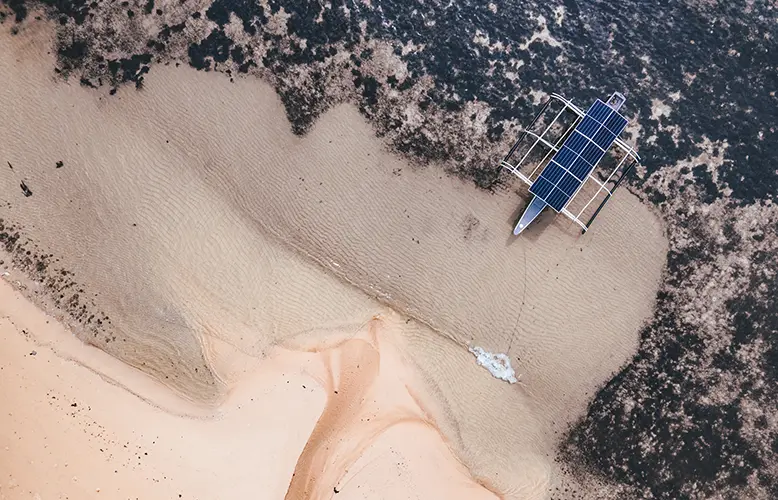
To counteract these impacts, local authorities and organizations are enforcing regulations to mitigate the damage. Initiatives include visitor limitations to vulnerable areas, stringent environmental protocols and campaigns to instill eco-consciousness among both locals and tourists. The collective aim is to strike a balance, where tourism and conservation coexist, ensuring that Coron’s natural wonders are preserved for those explorers who come after us.
Our exploration of Coron led us to seek individuals who were genuinely upholding sustainable practices amidst the rush of tourism— those who were effectively balancing preservation and growth on this globally acclaimed island. This curiosity led us to Susan Santos de Cárdenas and Antonio ‘Al’ Linsangan. As native Filipinos, they are deeply rooted in their commitment to protect their homeland. We realized quite quickly that these two had the pulse on what’s happened in Palawan province over the years and what the future has in store.
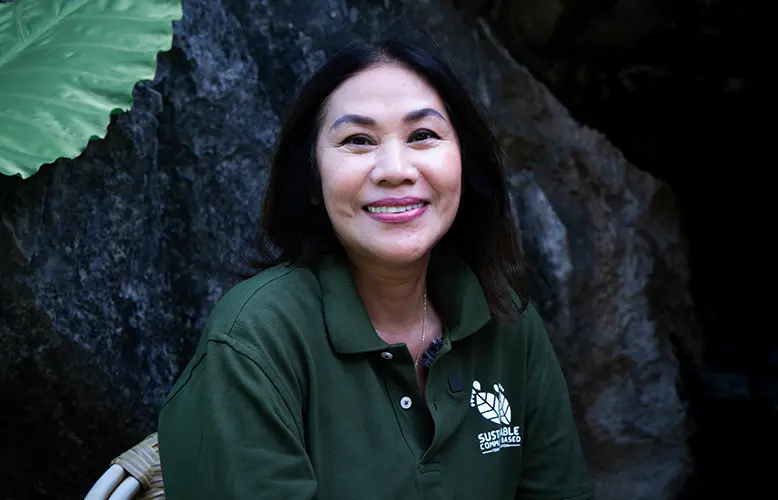
We learned about their first project called The Coron Initiative (TCI) in our search to find Palawan’s eco-champions. Conceptualized over a decade ago, TCI was founded on the idea that tourism and sustainability could live hand-in-hand. It was a comprehensive plan to meld environmentally responsible tourism with the preservation of the natural beauty and ecosystems of Coron and the other neighboring Calamianes Islands in the region.
This plan was not just topical, it was deeply rooted in the island’s communities and cultures.
Supported by the UNEP Regional Office for Asia and the Pacific, TCI was dedicated to the establishment of actionable and pragmatic sustainability protocols. These were designed to mitigate the impacts of climate change and over-tourism, ensuring that the unique ecosystems of these islands continue to thrive.
Through various educational programs, workshops and conferences, TCI worked with local operators that catered to tourism, arming them with knowledge, resources and access to the necessary educators and experts in the hospitality and tourism sectors. This enabled them to earn profit while avoiding further damage to the ecosystem. These events served as a platform for diverse stakeholders—including government agencies, NGOs and businesses—to collaborate and align their efforts for maximized impact.
TCI released a Sustainable Tourism Charter, which was the product of these collective efforts, outlining a concrete path toward balancing tourism and conservation. With an eye on future expansion, TCI’s model is now being tailored for implementation in other vulnerable coastal destinations across the Philippines, spearheaded by the duo, Susan and Al.
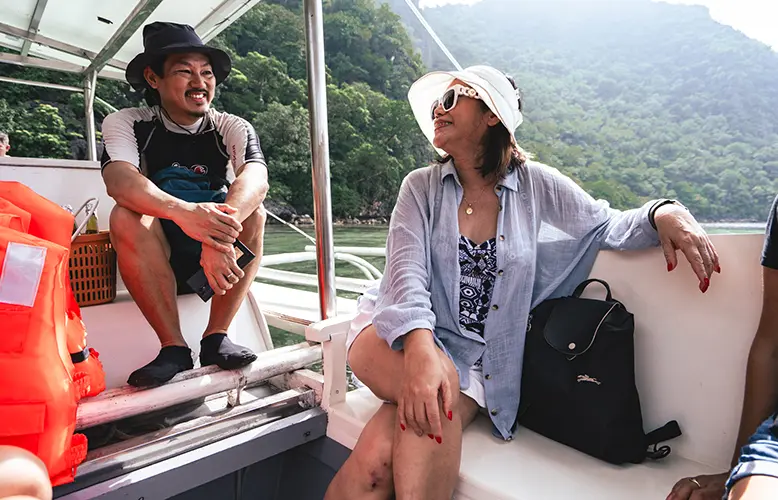
The topic of tourism is inescapable when you’re on a two-year global expedition. So, we ventured to Coron to learn from the experts themselves. We wanted to understand the depth of their work, especially in the context of an escalating climate crisis and the persistent issue of overtourism. Touching down even during the off-season, the evident influx of tourists was all around us.
Even in the pouring rain, the issue was staring us straight in the face. There were people EVERYWHERE. The island’s renowned attractions, though bathed in natural beauty, bore the weight of unrelenting visitor footprints. The spectacle of nature’s grandeur was juxtaposed with the undeniable pressure of human impact, underscoring the urgency of sustainable practices more than we anticipated.
Al, the Executive Director of Calamianes Conservation & Cultural Networks Inc. (CCCNI), was ready to introduce us to his array of ongoing projects, each a component of the original TCI plan. Together, we boarded a speedboat to Sangat Island Dive Resort, a locale of interest about 45 minutes away from Coron mainland. This journey marked the beginning of our exploration into the practical steps being taken to mitigate the challenges presented by increasing tourism and environmental strain.
Before reaching Sangat, our journey was punctuated by a visit to a secluded lagoon, off-limits to conventional tour operators. Al and his team had marked this pristine locale as an eco-zone, implementing strict visitor limitations and protocols to mitigate environmental impact. Access was granted only under the supervision of trained professionals, ensuring the delicate ecosystem remained undisturbed. Loving the tranquility, we couldn’t help but think what this place must have been like pre-tourism.
Pulling up to the Sangat dock, we were the only people onsite. That is, alongside Susan, one of the more charismatic individuals we had the chance of meeting on expedition thus far. From the minute we met her, she was explaining in detail what it takes to prevent greenwashing, the act of using marketing to highlight that a company’s offerings are sustainable, when in fact they are not. And, she was on a roll divulging what it takes for operations to truly live up to eco standards—as she’s one of the frontrunners in creating them.
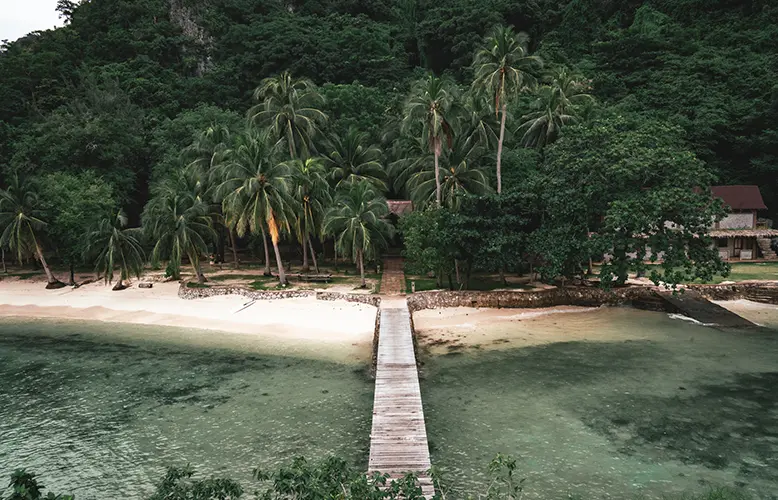
Susan, President & CEO of Society for Sustainable Tourism, has spent her career consulting and educating businesses on how to build sustainability into their corporate models. Her company operates as a NGO dedicated to fostering sustainable practices within the tourism and hospitality sectors—anchored in a mission to equip both public and private stakeholders with the tools and knowledge necessary for implementing responsible tourism development and environmental stewardship.
Her next project will be right here in Coron, as she was onsite to review Sangat Island and other resorts as Green Destinations Partner and Representative in Southeast Asia.
Susan is also the East Asia Regional Coordinator to support, help and recognize sustainable businesses with the Good Travel Program. This engagement support not only destinations but also businesses by how well they meet global sustainability standards. Capacity Buidling programs support destinations via Green Destinations Standards guidance while the tourism, leisure and hospitality industry get training via the Good Travel Program for businesses. Both destinations and tourism businesses are featured in the Good Travel Guide with their recognized good practice stories that lead by example.
Among the numerous tourism businesses Susan has evaluated, only a select few have achieved Green Destinations’ top sustainability ranking. She believes Sangat is on track to earning this distinction. Achieving such recognition demands a wholehearted dedication to sustainability, where each aspect of the operation supports broader goals of environmental care and social responsibility. It was special watching Susan in action, looking over every little detail of the property, alongside her trusted partner, Al.
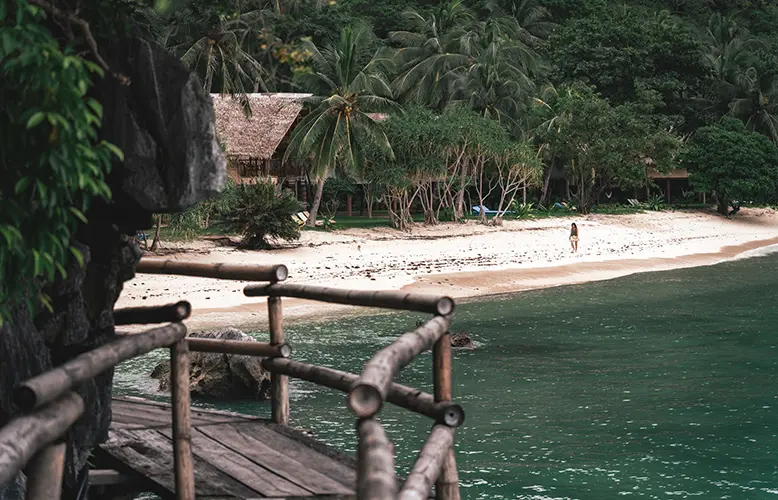
One of the most compelling draws that Sangat was putting forward was Coron’s first electric boat by OceanTera. We were lucky enough to embark on this extraordinary vessel’s maiden voyage, where we were taken to some of the pristine and untouched islands in the area. Blown away by the boat’s sophistication and sleek design akin to traditional Filipino boats, it hardly made a sound moving through the water and was able to take us just as far as we needed to go for a day’s worth of exploration.
At night, a celebrated Filipino chef, Laorence Castillo, presented unique creations from the sustainable food found on Sangat island. Prepared traditionally, the aim of this meal was to push boundaries using ingredients in unexpected ways, while also paying homage to his country and the local dishes that are loved by so many. The food was out of this world, and connected us to the Philippines that much more. He chose themes for each of the nights we were on-site, with the most exciting being how he used coconuts. Black-charred coconut was one of the most notable dishes that took the flavor experience to the next level.
And of course, there was the diving that Sangat is best known for, where we explored WW2 shipwrecks in peaceful solitude. Passing by pearl oyster farms and local divers looking for their dinner, we felt like we’d taken a few steps back in time to when the Calamianes Islands were not overrun by tourism. The natural wonder was still very much intact and the tranquility was ever present. Somehow, this team had cracked the code on how to keep this place shielded from the throes of over-tourism through best practices.
Navigating through the commotion of Coron, there emerged a question: how can an entity adhere to genuine sustainability practices amidst the whirlwind of expanding tourism?
It boils down to an unwavering commitment to eco-centric principles, while cutting through the noise. Authentic, sustainable tourism is achievable when operations are meticulously crafted to respect and preserve the natural environment. This involves a holistic approach that marries innovative, eco-friendly technology with traditional wisdom, ensuring minimal impact and optimal conservation.
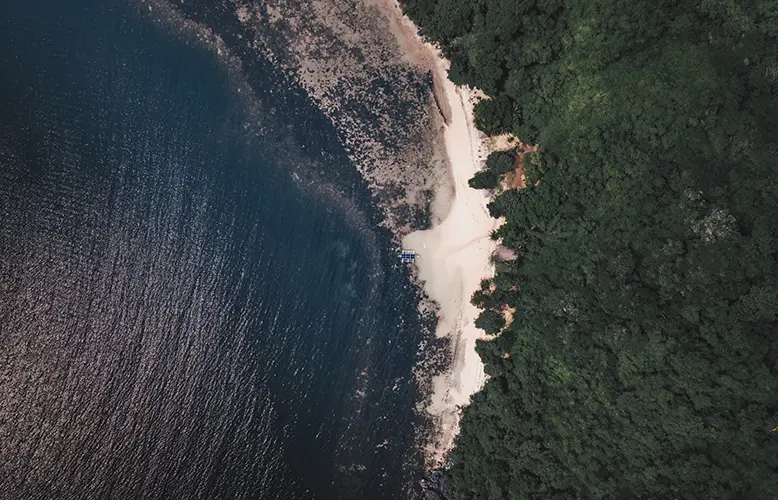
It means fostering a symbiotic relationship with local communities, where both parties are beneficiaries, and embedding educational and awareness programs to enhance environmental consciousness among those who are visiting and the appointed staff. In the midst of Coron’s bustling atmosphere, adherence to these sustainable principles is not just a theoretical aspiration but a practical and attainable objective, marking the intersection where conservation meets exploration—without compromise.
Leaving Coron, it was the first time in our travels where we felt there might be a way forward when it comes to managing the tourist boom. If people like Susan and Al can keep opening our eyes to the right places to go, and the right people to work with, we can invest our travel dollars wisely. We can team up with those who understand what it takes to explore responsibility.
A call to action for my fellow explorers: commit to diligence before choosing who to work with when it comes to accommodation, guides and local operators. Prioritize establishments that are not just immersed in, but also ardently protective of, the natural world. Seek out those who invest time and sincere efforts in conservation, who ensure their footprint is not just minimal but also positive. Go local as much as possible.
Resources like the Good Travel Guide stand as invaluable tools for discerning travelers, offering insights into operations that exemplify ethical and sustainable practices. Because every choice we make as travelers directly impacts the world’s natural wonders. By choosing wisely, we become active participants in their preservation, ensuring these awe-inspiring places can endure for generations to come.
_____
Andi Cross is a growth strategist, professional scuba diver and lead of the Edges of Earth expedition, highlighting stories of positive ocean progress and how to explore the world more consciously. To keep up with the expedition, follow the team on Instagram, LinkedIn, TikTok, Youtube and their website.





